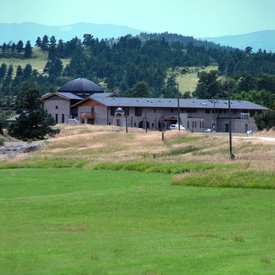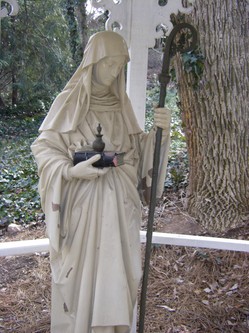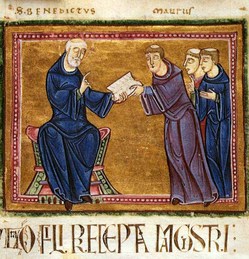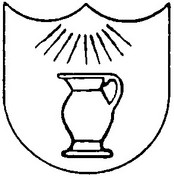The season of Lent is: "to offer in the joy of the Holy Spirit, of our own accord a measure of service...Less food, drink, sleep, speech, merriment, and with the joy of spiritual desire await holy Easter." (Rule of St Benedict, 49)
Benedictines: February 2009 Archives
The Benedictine nuns of the Abbey of St. Walburga in Virginia Dale,  started a small publishing business, the St. Walburga Press. The press publishes books, booklets, CD's, blank journals, note cards, and other small gift items created by the nuns, oblates and friends of the Abbey. The new online store features booklets by Mother Maria-Thomas Beil OSB, Sister Genevieve Glen OSB, and Father John Krenzke. Three blank journals, lined and unlined, with illustrations and quotations, were created by the staff of the St. Walburga Press. The store also sells works by Sister Genevieve and Sister Hildegard Dubnick OSB from other publishers. The nuns plan to add CD's and other gift items soon. Visit the store at <store.walburga.org>. For now, shipments are limited to the
started a small publishing business, the St. Walburga Press. The press publishes books, booklets, CD's, blank journals, note cards, and other small gift items created by the nuns, oblates and friends of the Abbey. The new online store features booklets by Mother Maria-Thomas Beil OSB, Sister Genevieve Glen OSB, and Father John Krenzke. Three blank journals, lined and unlined, with illustrations and quotations, were created by the staff of the St. Walburga Press. The store also sells works by Sister Genevieve and Sister Hildegard Dubnick OSB from other publishers. The nuns plan to add CD's and other gift items soon. Visit the store at <store.walburga.org>. For now, shipments are limited to the
O God, the boundless generosity of your favor is proclaimed by the wonders you have worked in your holy women. As we are taught by your holy virgin Walburga's example of purity and rejoice in the glory of her miracles, may she be our patron to gain for us your unfailing love.
One of the important Benedictine saints in the Church is the 8th century Saint Walburga and yet she is relatively unknown to many outside the world of monks and nuns. Her story is found here. You might find it interesting to note that Saint Walburga's relative is the Apostle to
In
 Since 1857, the Benedictine sisters of Elizabeth, NJ, also claim Saint Walburga as their patron.
Since 1857, the Benedictine sisters of Elizabeth, NJ, also claim Saint Walburga as their patron.
Also, we should mention the venerable witness of Saint Walburg Monastery in
Belmont Abbey's secondary patron is Saint Walburga. No fewer than two statues, one in the monastery and one in the grotto honor the saint. Plus, the monks honored the saint with a beautiful stained glass window in the Abbey Basilica.
The novena prayer to Saint Walburga
Holy Walburga, you dwell in the glory of heaven, gazing upon the face of the Triune God in the company of all the saints. I turn to you, full of trust in the words of Jesus Christ, "Amen, amen I say to you, the one who has faith in me will do the works I do, and greater far than these" (John
Ask this for me through Jesus Christ, our Lord, who lives and reigns in the unity of the Father and the Holy Spirit, one God for ever and ever. Amen.
Silence in the monastery confuses the world; it sometimes confuses me and there are times that I am frustrated by silence. The practice of silence is often misunderstood by those who live in monasteries because of an insufficient understanding of a "theology of silence." Family and friends think monks take a vow of silence. They get this idea from the clichés of the TV and movies where they see monks and nuns piously walking the halls of the abbey in silence with a mean looking superior hovering over the shoulder waiting for someone to slip-up. While I don't deny that this understanding may be rooted in some truth, or a least a vague sense of truth, it nonetheless lends itself to gross misunderstanding of the role of silence in the monastic life, indeed the need (and desire for) for silence in all people's lives.
What did Saint Benedict say about the practice of silence in his Rule? In one place he says:
 Let us do what the Prophet says: "I said, I will take heed of my ways, that I sin not with my tongue: I have set a guard to my mouth, I was dumb, and was humbled, and kept silence even from good things" (Psalm 38[39]:2-3). Here the prophet shows that, if at times we ought to refrain from useful speech for the sake of silence, how much more ought we to abstain from evil words on account of the punishment due to sin.
Let us do what the Prophet says: "I said, I will take heed of my ways, that I sin not with my tongue: I have set a guard to my mouth, I was dumb, and was humbled, and kept silence even from good things" (Psalm 38[39]:2-3). Here the prophet shows that, if at times we ought to refrain from useful speech for the sake of silence, how much more ought we to abstain from evil words on account of the punishment due to sin.
Therefore, because of the importance of silence, let permission to speak be seldom given to perfect disciples even for good and holy and edifying discourse, for it is written: "In much talk up shall not escape sin" (Proverbs 10:19). And elsewhere: "Death and life are in the power of the tongue" (Proverbs
Belmont Abbey's Father Abbot, Placid, put in our mailboxes the community's custom of silence that had been formulated in consultation with the community in 2006. Essentially it is outlines what's permitted and what's not. To me, it is less of a "wagging of the finger" as it is a way to focus our life yet again on a venerable practice that leads to freedom but yet takes discipline and freedom to engage our mind, hear and will. So what's expected? Following Vespers (c.
This work of silence is neither rigid and nor is unreasonable. In fact, I appreciate the periods of silence the community has worked out and I hope that my confreres will help me live by what's expected.
When I am participating in community days of the CL movement I practice silence with the group. We don't do this to shut up the incessant talker (though it's a nice by-product of the silence) or to force an agenda as it is a method to help us (me) to appreciate the beauty of God the Father's creation which is in front of us. So, it is not uncommon to walk in the woods, climbing a mountain, or sitting by the seashore and not talk to your neighbor. Sounds goofy? Perhaps for the uninitiated or the person who can't grasp the need to soak in the beauty of life, indeed all of creation, without the distracting noise of talking all the time, silence would be difficult or unhelpful or somewhat silly.
 Another example of the witness of silence is the Good Friday Way of the Cross that starts at Saint James Cathedral (Brooklyn) and ends at St. Peter's Church (Barclay St., NYC--ground zero) but crosses the Brooklyn Bridge and makes other stops to pray, listen to Scripture and sing spiritual songs. Imagine 5000+ people making the Way of the Cross in silence in the chilly air! People in NYC walking in silence following a cross in silence! What's the point? The point is: How does one understand, that is, judge (assess, evaluate, understand reality) the impact of the Lord's saving life, death and resurrection if all you hear is chatter? The gospel is made alive by the witness of 5000+ people walking in silence.
Another example of the witness of silence is the Good Friday Way of the Cross that starts at Saint James Cathedral (Brooklyn) and ends at St. Peter's Church (Barclay St., NYC--ground zero) but crosses the Brooklyn Bridge and makes other stops to pray, listen to Scripture and sing spiritual songs. Imagine 5000+ people making the Way of the Cross in silence in the chilly air! People in NYC walking in silence following a cross in silence! What's the point? The point is: How does one understand, that is, judge (assess, evaluate, understand reality) the impact of the Lord's saving life, death and resurrection if all you hear is chatter? The gospel is made alive by the witness of 5000+ people walking in silence.
One last example are my friends in the Fraternity of Saint Joseph (I call them CL's contemplatives-in-the-world who follow the Fraternity of Communion and Liberation) who spend a portion of each day in silence and at least one other day in an extended period of silence. For me, this is a witness to the presence of Christ and one's relationship with the Lord. Their discipline of silence is not merely turning off the radio, not speaking, not writing email or updating their blog, nor the simple absence of distracting noise but the intentional focus on the work of the Lord in prayer and study. How do you discern (verify) the will of God in the hussle-and-bussle of life? How do you hear the voice of the Lord calling you, as the Lord called Samuel or the apostles if all you encounter is the blaring of the stereo, the train or your mother yelling for you to answer the doorbell?
 Theologically, I think Patriarch Bartholomew I (of
Theologically, I think Patriarch Bartholomew I (of
The ascetic silence of apophaticism imposes on all of us -- educational and ecclesiastical institutions alike -- a sense of humility before the awesome mystery of God, before the sacred personhood of human beings, and before the beauty of creation. It reminds us that -- above and beyond anything that we may strive to appreciate and articulate -- the final word always belongs not to us but to God. This is more than simply a reflection of our limited and broken nature. It is, primarily, a calling to gratitude before Him who "so loved the world" (Jn
So, in my context silence is not punitive or a burden but way of living with an awareness that would otherwise be minimized and likely forgotten.
 The saint on whom we reflect today is called Bede. He was born in
The saint on whom we reflect today is called Bede. He was born in
 Sacred Scriptures were the constant source of Bede's theological reflection. Having made a careful critical study of the text (we have a copy of the monumental Codex Amiatinus of the Vulgate, on which Bede worked), he commented on the Bible, reading it in a Christological vein, namely, re-uniting two things: On one hand, he listened to what the text was saying exactly, he really wanted to listen and understand the text itself; on the other hand, he was convinced that the key to understanding sacred Scripture as the unique Word of God is Christ and with Christ, in his light, one understands the Old and the New Testament as "a" sacred Scripture.
Sacred Scriptures were the constant source of Bede's theological reflection. Having made a careful critical study of the text (we have a copy of the monumental Codex Amiatinus of the Vulgate, on which Bede worked), he commented on the Bible, reading it in a Christological vein, namely, re-uniting two things: On one hand, he listened to what the text was saying exactly, he really wanted to listen and understand the text itself; on the other hand, he was convinced that the key to understanding sacred Scripture as the unique Word of God is Christ and with Christ, in his light, one understands the Old and the New Testament as "a" sacred Scripture.The events of the Old and New Testament go together, they are together the path toward Christ, though expressed in different signs and institutions (it is what he calls "concordia sacramentorum"). For example, the tent of the covenant that Moses raised in the desert and the first and second
 Another topic loved by Bede is the history of the Church. After having taken interest in the period described in the Acts of the Apostles, he reviewed the history of the Fathers of the Church and the councils, convinced that the work of the Holy Spirit continues in history. In the Cronica Maiora, Bede traces a chronology that would become the basis of the universal calendar "ab incarnatione Domini." Up to then, time was calculated from the foundation of the city of
Another topic loved by Bede is the history of the Church. After having taken interest in the period described in the Acts of the Apostles, he reviewed the history of the Fathers of the Church and the councils, convinced that the work of the Holy Spirit continues in history. In the Cronica Maiora, Bede traces a chronology that would become the basis of the universal calendar "ab incarnatione Domini." Up to then, time was calculated from the foundation of the city of Bede was also an illustrious teacher of liturgical theology. In the homilies on the Sunday Gospels and those of feast days, he develops a true mystagogy, educating the faithful to celebrate joyfully the mysteries of the faith and to reproduce them consistently in life, while expecting their full manifestation of the return of Christ, when, with our glorified bodies, we will be admitted in offertory procession to the eternal liturgy of God in heaven. Following the "realism" of the catecheses of Cyril, Ambrose and Augustine, Bede teaches that the sacraments of Christian initiation make every faithful person "not only a Christian but Christ." In fact, every time that a faithful soul receives and guards the Word of God with love, in imitation of Mary, he conceives and generates Christ again. And every time that a group of neophytes receives the Easter sacraments, the Church is "self-generated," or to use a still more daring expression, the Church becomes "Mother of God," participating in the generation of her children, by the work of the Holy Spirit.
Thanks to this way of making theology, interlacing the Bible, the liturgy and history, Bede has a timely message for the different "states of life":
a) For scholars (doctores ac doctrices) he recalls two essential tasks: to scrutinize the wonders of the Word of God to present it in an attractive way to the faithful; to show the dogmatic truths avoiding the heretical complications and keeping to the "Catholic simplicity," with attention to the small and humble to whom God is pleased to reveal the mysteries of the Kingdom.
b) For pastors, that for their part, must give priority to preaching, not only through the verbal or hagiographic language, but also valuing icons, processions and pilgrimages. Bede recommends to them the use of the vernacular, as he himself does, explaining in
c) For consecrated people who are dedicated to the Divine Office, living in the joy of fraternal communion and progressing in the spiritual life through ascesis and contemplation, Bede recommends to take care of the apostolate -- no one has the Gospel just for himself, but must regard it as a gift also for others -- either by collaborating with the Bishops in pastoral activities of various types in favor of the young Christian communities, or being available to the evangelizing mission to the pagans, outside their own country, as "peregrini pro amore Dei."
Placed in this perspective, in the commentary to the Canticle of Canticles, Bede presents the synagogue and the Church as collaborators in the propagation of the Word of God. Christ the Spouse desires an industrious Church, "bronzed by the fatigues of evangelization" -- clear is the reference to the word of the Canticle of Canticles (1:5), where the Bride says: "Nigra sum sed formosa" (I am brown, but beautiful) -- attempts to till other fields or vines and to establish among the new populations "not a provisional bell but a stable dwelling, namely, to insert the Gospel in the social fabric and the cultural institutions. In this perspective, the saintly Doctor exhorts the lay faithful to be assiduous to the religious instruction, imitating those "insatiable evangelical multitudes who did not even give the Apostles time to eat." He teaches them how to pray constantly, "reproducing in life what they celebrate in the liturgy," offering all actions as spiritual sacrifices in union with Christ. To parents he explains that also in their small domestic realm they can exercise "the priestly office of pastors and guides," by giving Christian formation to the children and states that he knows many faithful (men and women, spouses and celibates) "capable of an irreproachable conduct that, if suitably pursued, could approach daily Eucharistic communion ("Epist. ad Ecgbertum," ed. Plummer, p. 419).
 The fame of holiness and wisdom that Bede enjoyed already in life, served to merit him the title of "Venerable." He is thus called also by Pope Sergius I, when he wrote his abbot in 701 requesting to make him come temporarily to
The fame of holiness and wisdom that Bede enjoyed already in life, served to merit him the title of "Venerable." He is thus called also by Pope Sergius I, when he wrote his abbot in 701 requesting to make him come temporarily to Let us pray that also today there be personalities of Bede's stature, to keep the whole Continent united; let us pray so that all of us are willing to rediscover our common roots, to be builders of a profoundly human and genuinely Christian Europe.
(Wednesday General Audience, Rome, 18 February 2009)
Life in a monastery is never boring. Living our lives seriously hardly leaves room for idleness. The abbey welcomes Christ in the visitors, including vocation guests, we receive. The presence of guests reminds us that we Christ is among us. And I am of the opinion that a religious house should rarely be without guests. The round of prayer, work, reading, dining (feeding is crude, so we politely dine) and private time is a lot. At the moment, time for self is not as plentiful as I want or need especially since I have to prepare for teaching and I want to do some study.
 One of my least favorite domestic chores is painting. Actually, I hate painting (probably because my father never really liked it either) and I only initiate the task when it is needed, or asked. I'd rather pay professionals to do the job of preparing the walls, painting and cleaning up. Here at Mary, Help of Christians (Belmont) Abbey I've been asked along with two others to paint a few hallways and a room. The companions are fine to work with, though one drives the work, getting mucked up with paint isn't my idea of fun. BUT the walls do look good and the abbot and other monks are pleased. Happy to oblige. I am just hoping that we don't have to paint the very long outside porch. The passage from
One of my least favorite domestic chores is painting. Actually, I hate painting (probably because my father never really liked it either) and I only initiate the task when it is needed, or asked. I'd rather pay professionals to do the job of preparing the walls, painting and cleaning up. Here at Mary, Help of Christians (Belmont) Abbey I've been asked along with two others to paint a few hallways and a room. The companions are fine to work with, though one drives the work, getting mucked up with paint isn't my idea of fun. BUT the walls do look good and the abbot and other monks are pleased. Happy to oblige. I am just hoping that we don't have to paint the very long outside porch. The passage from
 On this the feast of the great Saint Scholastica, the twin sister of Saint Benedict, I thought it would be appropriate to hear a few words about the significant connection between the Benedictines (Sts Benedict & Scholastica and Pope Benedict) and Father Luigi Giussani.
On this the feast of the great Saint Scholastica, the twin sister of Saint Benedict, I thought it would be appropriate to hear a few words about the significant connection between the Benedictines (Sts Benedict & Scholastica and Pope Benedict) and Father Luigi Giussani.
Signs of spiritual friendship
by Don Giacomo Tantardini (In 30 Days, May 2005)
...The hundredfold is not the outcome of a project, of a program. My real program of government is that of not doing my own will, of not following my own ideas, but of setting myself to listen, with the whole Church, to the word and will of the Lord and let myself be led by Him, so that it is He Himself who leads the Church in this hour of our history, Benedict XVI said again in the sermon of the mass opening his ministry. The hundredfold here below, like the eternal life, has a beginning, a "permanent" source (each word from the first appearance of Benedict XVI in St Peter's Square, that was packed with Romans hurrying to see the new Pope, remains in the memory: Trusting in his permanent help). The permanent beginning is Jesus Christ, the Lord risen.
The Church is living because Christ is living, because he is truly risen (Easter Sunday 24 April). And on Sunday 1 May, when, addressing the Churches of the East which were celebrating Easter, he repeated with force Christós anesti! Yes, Christ is risen, is truly risen!, the immediate applause that rose from the square packed with faithful up to that window was very fine.
Here the communion of mind and heart among Saint Benedict, Benedict XVI, Don Giussani and the most ordinary believer is luminous and total.
 Don Giussani always kept the gaze of his life and heart fixed on Christ (Cardinal Ratzinger, in Milan Cathedral, at Don Guissani's funeral). We need men who keep their eyes looking at God, learning from there true humanity (in Subiaco). And, again in Subiaco, Cardinal Ratzinger concluded his lecture by quoting the more beautiful phrase that Saint Benedict repeats twice in the Rule: Put absolutely nothing before Christ who can lead us all to eternal life. Here, chapter 72: Christo omnino nihil praeponant. In chapter 4: Nihil amori Christi praeponere/ put nothing before the love of Christ.
Don Giussani always kept the gaze of his life and heart fixed on Christ (Cardinal Ratzinger, in Milan Cathedral, at Don Guissani's funeral). We need men who keep their eyes looking at God, learning from there true humanity (in Subiaco). And, again in Subiaco, Cardinal Ratzinger concluded his lecture by quoting the more beautiful phrase that Saint Benedict repeats twice in the Rule: Put absolutely nothing before Christ who can lead us all to eternal life. Here, chapter 72: Christo omnino nihil praeponant. In chapter 4: Nihil amori Christi praeponere/ put nothing before the love of Christ.

